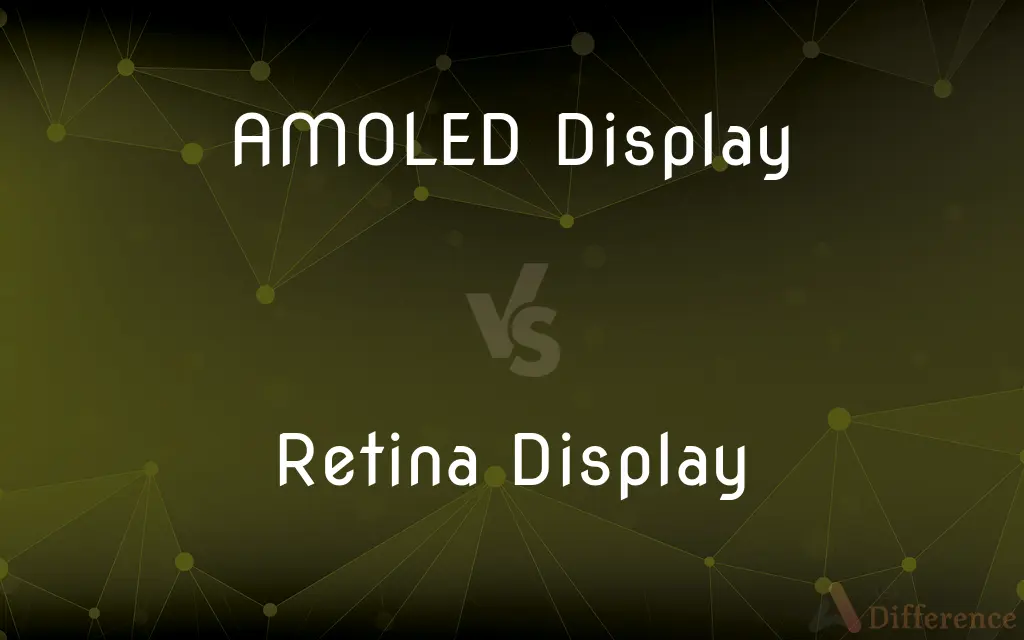AMOLED Display vs. Retina Display — What's the Difference?
By Tayyaba Rehman — Published on January 26, 2024
AMOLED displays use organic compounds for pixels, offering deep blacks and high contrast ratios. Retina displays, a term coined by Apple, screens with a pixel density high enough that individual pixels are indiscernible at a normal viewing distance.

Difference Between AMOLED Display and Retina Display
Table of Contents
ADVERTISEMENT
Key Differences
AMOLED Display: AMOLED (Active Matrix Organic Light Emitting Diode) displays utilize organic materials that emit light when an electric current is applied, known for their vibrant colors and deep blacks. Retina Display: Retina display is a marketing term used by Apple to describe displays with a high pixel density, where pixels are not visible to the naked eye at a normal viewing distance.
AMOLED Display: These displays are characterized by excellent contrast ratios and true blacks, as individual pixels can be turned off completely. Retina Display: Retina displays emphasize clarity and sharpness, with the high pixel density resulting in smooth lines and clear text.
AMOLED Display: AMOLED screens typically exhibit better viewing angles and can display a wide range of colors with great accuracy. Retina Display: Retina displays are known for their color accuracy and uniformity, maintaining consistency across the screen.
AMOLED Display: Energy efficiency is another advantage of AMOLED displays, especially in scenarios where black or dark colors are predominant on the screen. Retina Display: Retina displays are not specifically known for energy efficiency but focus on delivering high resolution and pixel density for visual fidelity.
AMOLED Display: These displays are used in various devices, including smartphones, tablets, and TVs, recognized for their thinness and flexibility in design. Retina Display: Retina displays are exclusively used in Apple products, including iPhones, iPads, and MacBooks, contributing to the premium quality and aesthetic of these devices.
ADVERTISEMENT
Comparison Chart
Technology
Organic compounds for pixel illumination
High pixel density screens
Key Features
Deep blacks, high contrast, vibrant colors
High clarity, pixel density, smooth lines
Viewing Angles
Wide viewing angles
Consistent color and clarity across angles
Energy Efficiency
More efficient with dark themes
Standard efficiency, focused on resolution
Usage
Used in various brands and device types
Exclusive to Apple products
Compare with Definitions
AMOLED Display
AMOLED displays provide excellent viewing angles and color accuracy.
The colors on my AMOLED display remain consistent even when viewed from the side.
Retina Display
Retina displays maintain high-quality color accuracy and uniformity.
Viewing photos on my iPad's Retina display shows true-to-life colors.
AMOLED Display
An AMOLED display is a screen technology that uses organic compounds for illumination.
The smartphone's AMOLED display made the colors in the photos look incredibly vibrant.
Retina Display
Retina displays prioritize high resolution and pixel density for enhanced visual fidelity.
Reading eBooks is comfortable on the Retina display due to its smooth lines and text clarity.
AMOLED Display
AMOLED technology allows for thinner and more flexible screen designs.
The new wearable device uses an AMOLED display for its curved screen.
Retina Display
Retina displays are known for their visual clarity and sharpness.
The sharpness of the Retina display is ideal for graphic design work.
AMOLED Display
AMOLED displays are known for their deep blacks and high contrast ratios.
Watching movies on my AMOLED display phone is great because of the true blacks it produces.
Retina Display
A Retina display is an Apple-branded term for screens with a high pixel density that the human eye can't discern individual pixels at a normal viewing distance.
The Retina display on my MacBook makes text and images exceptionally crisp and clear.
AMOLED Display
AMOLED screens are energy-efficient, especially when displaying dark themes.
My phone's battery lasts longer with dark mode, thanks to its AMOLED display.
Retina Display
This type of display is used exclusively in Apple products.
The iPhone's Retina display contributes to its premium look and feel.
Common Curiosities
Are AMOLED displays good for battery life?
AMOLED displays are generally more energy-efficient, especially when displaying dark themes, thereby often contributing to better battery life.
What does AMOLED stand for?
AMOLED stands for Active Matrix Organic Light Emitting Diode.
What makes Retina displays unique in terms of resolution?
Retina displays have a high resolution that provides sharp and clear images, making pixels undetectable to the naked eye at a standard viewing distance.
How does viewing angle affect AMOLED and Retina displays?
AMOLED displays typically offer wider viewing angles with consistent color and brightness, whereas Retina displays maintain clarity and color accuracy across different angles.
Do AMOLED displays offer true blacks?
Yes, AMOLED displays can produce true blacks by turning off individual pixels completely.
Can the brightness of AMOLED displays compare to Retina displays?
AMOLED displays generally offer higher contrast levels with deeper blacks, while Retina displays are known for their balanced brightness and contrast suitable for various lighting conditions.
What is the main characteristic of a Retina display?
The main characteristic of a Retina display is its high pixel density, which makes individual pixels indiscernible at a normal viewing distance.
Can Retina displays only be found on Apple products?
Yes, the term "Retina display" is a trademark of Apple and is exclusively used for their products.
Which devices commonly use AMOLED displays?
AMOLED displays are commonly used in various smartphones, tablets, and TVs across different brands.
Is there a difference in color accuracy between AMOLED and Retina displays?
Both AMOLED and Retina displays are known for their color accuracy, but AMOLED displays often have more vibrant colors and deeper blacks, while Retina displays focus on color uniformity and natural tones.
Which display technology is better for watching movies: AMOLED or Retina?
For watching movies, AMOLED displays might be preferred for their deep blacks and vibrant colors, enhancing the viewing experience, especially in dark scenes. However, preference can vary based on individual perception and the specific device.
What is the impact of AMOLED displays on device design?
AMOLED displays allow for thinner and more flexible designs, leading to slimmer and sometimes curved device profiles.
How do Retina displays affect the battery life of Apple devices?
Retina displays, due to their high pixel density and resolution, can consume more power, potentially impacting battery life depending on usage and other factors.
Are Retina displays better for eye comfort?
Retina displays are designed to reduce pixel visibility, which can provide a more comfortable viewing experience, especially for reading or detailed graphic work.
Is there a noticeable difference in screen sharpness between AMOLED and Retina displays?
Screen sharpness is excellent on both display types, but Retina displays focus on minimizing pixel visibility, while AMOLED displays emphasize vibrant colors and deep contrast.
Share Your Discovery

Previous Comparison
Server vs. Network
Next Comparison
Faber vs. ElicaAuthor Spotlight
Written by
Tayyaba RehmanTayyaba Rehman is a distinguished writer, currently serving as a primary contributor to askdifference.com. As a researcher in semantics and etymology, Tayyaba's passion for the complexity of languages and their distinctions has found a perfect home on the platform. Tayyaba delves into the intricacies of language, distinguishing between commonly confused words and phrases, thereby providing clarity for readers worldwide.
















































